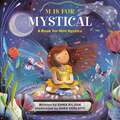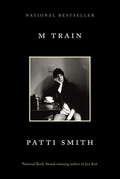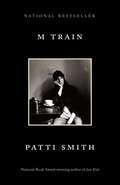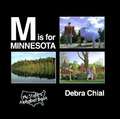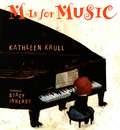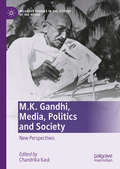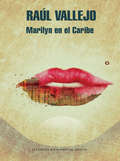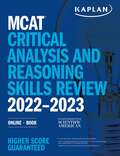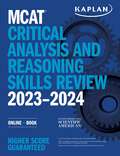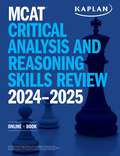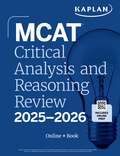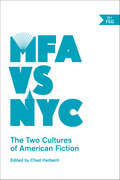- Table View
- List View
M Is for Mystical: A Book for Mini Mystics
by Emma MildonMindfulness is as easy as ABC: make learning the alphabet a portal to learning about the world with bestselling author Emma Mildon&’s illuminating picture book. In a time when mindfulness is becoming mainstream and parents are more aware of the options available to them, they are seeking content to educate and empower their children. This is largely reflected in the huge increase in traffic, demand, and engagement of online content serving holistic parenting insights and new age tips for the new age parent. So, why not make mindfulness as easy as learning your ABCs? An A-Z of spirituality in simple explanations and fun, engaging exercises for kids—yoga, breathwork, oils to help calm or energize, mudras, to crystals—M Is for Mystical offers tools to transform little lives.
M Train
by Patti SmithFrom the National Book Award-winning author of Just Kids: an unforgettable odyssey into the mind of this legendary artist, told through the prism of cafés and haunts she has visited and worked in around the world. M Train is a journey through seventeen "stations." It begins in the tiny Greenwich Village café where Smith goes every morning for black coffee, ruminates on the world as it is and the world as it was, and writes in her notebook. We then travel, through prose that shifts fluidly between dreams and reality, past and present, across a landscape of creative aspirations and inspirations: from Frida Kahlo's Casa Azul in Mexico, to a meeting of an Arctic explorer's society in Berlin; from the ramshackle seaside bungalow in New York's Far Rockaway that Smith buys just before Hurricane Sandy hits, to the graves of Genet, Plath, Rimbaud and Mishima. Woven throughout are reflections on the writer's craft and on artistic creation, alongside signature memories, including of her life in Michigan with her husband, guitarist Fred Sonic Smith, whose untimely death was an irremediable loss. For it is loss, as well as the consolation we might salvage from it, that lies at the heart of this exquisitely told memoir, one augmented by stunning black-and-white Polaroids taken by Smith herself. M Train is a meditation on endings and on beginnings: a poetic tour de force by one of the most brilliant, multi-platform artists at work today.
M Train
by Patti SmithFrom the National Book Award-winning author of Just Kids: an unforgettable odyssey of a legendary artist, told through the prism of the cafés and haunts she has worked in around the world. It is a book Patti Smith has described as "a roadmap to my life." M Train begins in the tiny Greenwich Village café where Smith goes every morning for black coffee, ruminates on the world as it is and the world as it was, and writes in her notebook. Through prose that shifts fluidly between dreams and reality, past and present, and across a landscape of creative aspirations and inspirations, we travel to Frida Kahlo's Casa Azul in Mexico; to a meeting of an Arctic explorer's society in Berlin; to a ramshackle seaside bungalow in New York's Far Rockaway that Smith acquires just before Hurricane Sandy hits; and to the graves of Genet, Plath, Rimbaud, and Mishima. Woven throughout are reflections on the writer's craft and on artistic creation. Here, too, are singular memories of Smith's life in Michigan and the irremediable loss of her husband, Fred Sonic Smith. Braiding despair with hope and consolation, illustrated with her signature Polaroids, M Train is a meditation on travel, detective shows, literature, and coffee. It is a powerful, deeply moving book by one of the most remarkable multiplatform artists at work today.From the Hardcover edition.
M Train
by Patti SmithNational Best Seller From the National Book Award-winning author of Just Kids: an unforgettable odyssey of a legendary artist, told through the prism of the cafés and haunts she has worked in around the world. It is a book Patti Smith has described as "a roadmap to my life." M Train begins in the tiny Greenwich Village café where Smith goes every morning for black coffee, ruminates on the world as it is and the world as it was, and writes in her notebook. Through prose that shifts fluidly between dreams and reality, past and present, and across a landscape of creative aspirations and inspirations, we travel to Frida Kahlo's Casa Azul in Mexico; to a meeting of an Arctic explorer's society in Berlin; to a ramshackle seaside bungalow in New York's Far Rockaway that Smith acquires just before Hurricane Sandy hits; and to the graves of Genet, Plath, Rimbaud, and Mishima. Woven throughout are reflections on the writer's craft and on artistic creation. Here, too, are singular memories of Smith's life in Michigan and the irremediable loss of her husband, Fred Sonic Smith. Braiding despair with hope and consolation, illustrated with her signature Polaroids, M Train is a meditation on travel, detective shows, literature, and coffee. It is a powerful, deeply moving book by one of the most remarkable multiplatform artists at work today.From the Hardcover edition.
M is for Minnesota
by Debra ChialThis book, from the My State's Alphabet series, includes facts about Minnesota while helping beginning readers master their ABCs.
M is for Music
by Kathleen KrullMusic and the alphabet have always gone together. Don't kids learn their letters by singing the ABCs? But you've never seen--orheard--a musical alphabet like this one. Beloved tunes. Unusual instruments. Legendary virtuosos. From anthems to zydeco, the language of music and the music of language harmonize in one superb symphony. It's a funky fusion for songsters of all ages! Playful text opens up the world of music to the youngest readers, and conversational endnotes offer older readers a springboard to further musical explorations.
M.K. Gandhi, Media, Politics and Society: New Perspectives (Palgrave Studies in the History of the Media)
by Chandrika KaulThis Palgrave Pivot showcases new research on M.K. Gandhi or Mahatma Gandhi, and the press, telegraphs, broadcasting and popular culture. Despite Gandhi being the subject of numerous books over the past century, there are few that put media centre stage. This edited collection explores both Gandhi’s own approach to the press, but also how different advocacy groups and the media, within India and overseas, engaged with Gandhi, his ideology and methodology, to further their own causes. The timeframe of the book extends from the late nineteenth century up to the present, and the case studies draw inspiration from a number of disciplinary approaches.
MARILYN EN EL CARIBE E-BOOK
by Raul VallejoEn su fallo, el jurado del Premio de Novela Breve Pontificia UniversidadJaveriana 2014 señaló que Marilyn en el Caribe, la obra ganadora, es unanovela "... fresca y de escritura muy fluida en la que hay que destacartambién el manejo de los diálogos. Su estructura propone una lectura condiversas líneas de interpretación; presenta un juego meta ?ccional entresujetos históricos y personajes de ficción, conjugados de maneraverosímil. Además, combina diversos registros de lenguaje, logrando ununiverso poético y narrativo pleno de posibilidades estéticas".
MCAT Critical Analysis and Reasoning Skills Review 2022-2023: Online + Book (Kaplan Test Prep)
by Kaplan Test PrepKaplan&’s MCAT Critical Analysis and Reasoning Skills Review 2022–2023 offers an expert study plan, detailed subject review, and hundreds of online and in-book practice questions—all authored by the experts behind the MCAT prep course that has helped more people get into medical school than all other major courses combined. Prepping for the MCAT is a true challenge. Kaplan can be your partner along the way—offering guidance on where to focus your efforts and how to organize your review. This book has been updated to match the AAMC&’s guidelines precisely—no more worrying about whether your MCAT review is comprehensive!The Most PracticeMore than 100 questions in the book and access to even more online—more practice than any other MCAT CARS book on the market.The Best PracticeComprehensive CARS subject review is written by top-rated, award-winning Kaplan instructors.Expanded content review for research design and the execution of research, and data-based and statistical analysis.All material is vetted by editors with advanced science degrees and by a medical doctor.Online resources, including a full-length practice test, help you practice in the same computer-based format you&’ll see on Test Day.Expert GuidanceWe know the test: The Kaplan MCAT team has spent years studying every MCAT-related document available. Kaplan&’s expert psychometricians ensure our practice questions and study materials are true to the test.
MCAT Critical Analysis and Reasoning Skills Review 2023-2024: Online + Book (Kaplan Test Prep)
by Kaplan Test PrepKaplan&’s MCAT Critical Analysis and Reasoning Skills Review 2023–2024 offers an expert study plan, detailed subject review, and hundreds of online and in-book practice questions—all authored by the experts behind the MCAT prep course that has helped more people get into medical school than all other major courses combined.Prepping for the MCAT is a true challenge. Kaplan can be your partner along the way—offering guidance on where to focus your efforts and how to organize your review. This book has been updated to match the AAMC&’s guidelines precisely—no more worrying about whether your MCAT review is comprehensive!The Most PracticeMore than 100 questions in the book and access to even more online—more practice than any other MCAT CARS book on the market.The Best PracticeComprehensive CARS subject review is written by top-rated, award-winning Kaplan instructors.All material is vetted by editors with advanced science degrees and by a medical doctor.Online resources, including a full-length practice test, help you practice in the same computer-based format you&’ll see on Test Day.Expert GuidanceWe know the test: The Kaplan MCAT team has spent years studying every MCAT-related document available. Kaplan&’s expert psychometricians ensure our practice questions and study materials are true to the test.
MCAT Critical Analysis and Reasoning Skills Review 2024-2025: Online + Book (Kaplan Test Prep)
by Kaplan Test PrepKaplan&’s MCAT Critical Analysis and Reasoning Skills Review 2024-2025 offers an expert study plan, detailed subject review, and hundreds of online and in-book practice questions—all authored by the experts behind the MCAT prep course that has helped more people get into medical school than all other major courses combined.Prepping for the MCAT is a true challenge. Kaplan can be your partner along the way—offering guidance on where to focus your efforts and how to organize your review. This book has been updated to match the AAMC&’s guidelines precisely—no more worrying about whether your MCAT review is comprehensive!The Most PracticeMore than 100 questions in the book and access to even more online—more practice than any other MCAT CARS book on the market.The Best PracticeComprehensive CARS subject review is written by top-rated, award-winning Kaplan instructors.All material is vetted by editors with advanced science degrees and by a medical doctor.Online resources, including a full-length practice test, help you practice in the same computer-based format you&’ll see on Test Day.Expert GuidanceWe know the test: The Kaplan MCAT team has spent years studying every MCAT-related document available. Kaplan&’s expert psychometricians ensure our practice questions and study materials are true to the test.
MCAT Critical Analysis and Reasoning Skills Review 2025-2026: Online + Book (Kaplan Test Prep)
by Kaplan Test PrepKaplan&’s MCAT Critical Analysis and Reasoning Skills Review 2024-2025 offers an expert study plan, detailed subject review, and hundreds of online and in-book practice questions—all authored by the experts behind the MCAT prep course that has helped more people get into medical school than all other major courses combined.Prepping for the MCAT is a true challenge. Kaplan can be your partner along the way—offering guidance on where to focus your efforts and how to organize your review. This book has been updated to match the AAMC&’s guidelines precisely—no more worrying about whether your MCAT review is comprehensive!The Most PracticeMore than 100 questions in the book and access to even more online—more practice than any other MCAT CARS book on the market.The Best PracticeComprehensive CARS subject review is written by top-rated, award-winning Kaplan instructors.All material is vetted by editors with advanced science degrees and by a medical doctor.Online resources, including a full-length practice test, help you practice in the same computer-based format you&’ll see on Test Day.Expert GuidanceWe know the test: The Kaplan MCAT team has spent years studying every MCAT-related document available. Kaplan&’s expert psychometricians ensure our practice questions and study materials are true to the test.
MFA vs NYC: The Two Cultures of American Fiction
by Chad HarbachWriters write—but what do they do for money?In a widely read essay entitled "MFA vs NYC," bestselling novelist Chad Harbach (The Art of Fielding) argued that the American literary scene has split into two cultures: New York publishing versus university MFA programs. This book brings together established writers, MFA professors and students, and New York editors, publicists, and agents to talk about these overlapping worlds, and the ways writers make (or fail to make) a living within them. Should you seek an advanced degree, or will workshops smother your style? Do you need to move to New York, or will the high cost of living undo you? What's worse—having a day job or not having health insurance? How do agents decide what to represent? Will Big Publishing survive? How has the rise of MFA programs affected American fiction? The expert contributors, including George Saunders, Elif Batuman, and Fredric Jameson, consider all these questions and more, with humor and rigor. MFA vs NYC is a must-read for aspiring writers, and for anyone interested in the present and future of American letters.
MHD-16 Bhartiya Upanyas Vivechana - IGNOU
by IgnouEleven articles have been compiled in this curriculum. Development and expansion of the Indian novel in these articles have been seriously discussed. This book will help students to study novels.
MHD-4 Gaddhaya Sahitaya ki anya Vidhayain-II - IGNOU
by IgnouThis book written for MA hIndi course has section an autobiography, author mainpoints and its importance.
MHD-4 Hindi Natak aur Rangmanch-I - IGNOU
by IgnouIn this section the students gets the information about the times of Bhartendu till the current times. It also studies play and theatre of hindi.
MHD-4 Natak aur anya Gaddhaya Vidhayain (2) - IGNOU
by IgnouIt has drama's process and play's one is Mohan Rakesh and Dharam Veer Bharti has to be read.
MHD-4 Natak aur anya Gaddhaya Vidhayain (4) - IGNOU
by IgnouIn this book reader will read about plays and other more process.
MHD-4 Natak aur anya Gaddhaya Vidhayain (6) - IGNOU
by IgnouThis book gives precise discription of Bavelggne, memories and interview techniqnis in hindi literature.
MHD-5 Ras-Chintan ke Vividh Aayam - IGNOU
by IgnouIt reflects the various dimensions of pleasure - theory has been discussed in detail. pleasure in place of contemplation is the most important element of literature . In this contemplation the subtle movements of the human mind experiences the wonderful mix of emotions and knowledge.
MHD01 Aadi Kavya - IGNOU
by IgnouThe M.A. It is the first course of Hindi has four sections. Etc. Poetry, devotion Kawy- (poetic attributes), Bhakti Kawy- (Sagun poetry) and poetry Sagun. The first section is the unit in which four of Adikawy Prithviraj Raso composed poetry and fiction seen in the eyes of Chandbrdai vidyapati describes compositions.
MHD01 Bhakti Kavya - IGNOU
by IgnouThis is the second volume of devotional poetry. Sagun Bhakti poetry and poetic prose in which the attributes of the two sections. Section two of the main attributes in this section Bhakti poet Kabir's poetry and writings describe Jaycee. Jaycee in this verse of poetry and his work has been described Pdmawat special.
MHD01 Bhakti Kavya-2 - IGNOU
by IgnouSection three of the attributes in this section Baktikawy creators - Tulsi, Mira and Soor - is described. Which is four units. Surdas in devotion to Krishna, Meera describes the devotion and love to krishna of his poetry have been analyzed and Tulsidas. In this poetic description Tulsi described the Chanda by the Ramcharitmanas.
MHD01 Hindi Kavya Vivechana - IGNOU
by IgnouIn this book described about major poems which are written in Aadikal, Bhaktikal and Ritikal. In this section study. Prithviraj Raso and covers the time and vidyapati phraseology
MHD01 Reeti Kavya - IGNOU
by IgnouThe creators of the three major poetic manner in this section - describes compositions of Bhihari, Gnanand and Padmakar. It has three units which are described in poems. Bihari's poetry, the poetry and Padmakar Gnanand poetry. Sringara the poetry and mystery Actor- Actoress is described in detail. This section describes the characteristics of Ritikawy.
